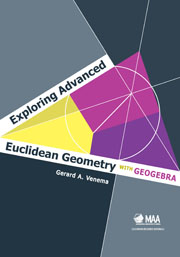Book contents
- Frontmatter
- Preface
- Contents
- 0 A Quick Review of Elementary Euclidean Geometry
- 1 The Elements of GeoGebra
- 2 The Classical Triangle Centers
- 3 Advanced Techniques in GeoGebra
- 4 Circumscribed, Inscribed, and Escribed Circles
- 5 The Medial and Orthic Triangles
- 6 Quadrilaterals
- 7 The Nine-Point Circle
- 8 Ceva's Theorem
- 9 The Theorem of Menelaus
- 10 Circles and Lines
- 11 Applications of the Theorem of Menelaus
- 12 Additional Topics in Triangle Geometry
- 13 Inversions in Circles
- 14 The Poincaré Disk
- References
- Index
- About the Author
14 - The Poincaré Disk
- Frontmatter
- Preface
- Contents
- 0 A Quick Review of Elementary Euclidean Geometry
- 1 The Elements of GeoGebra
- 2 The Classical Triangle Centers
- 3 Advanced Techniques in GeoGebra
- 4 Circumscribed, Inscribed, and Escribed Circles
- 5 The Medial and Orthic Triangles
- 6 Quadrilaterals
- 7 The Nine-Point Circle
- 8 Ceva's Theorem
- 9 The Theorem of Menelaus
- 10 Circles and Lines
- 11 Applications of the Theorem of Menelaus
- 12 Additional Topics in Triangle Geometry
- 13 Inversions in Circles
- 14 The Poincaré Disk
- References
- Index
- About the Author
Summary
In this final chapter we study the Poincaré disk model for hyperbolic geometry. Even though hyperbolic geometry is a non-Euclidean geometry, the topic is nonetheless appropriate for inclusion in a treatment of Euclidean geometry because the Poincaré disk is built within Euclidean geometry. The main tool used in the construction of the Poincaré disk model is inversion in Euclidean circles, so the tools you made in Chapter 13 will be used in this chapter to perform hyperbolic constructions. Many of the constructions in this chapter were inspired by those in the beautiful paper [7] by Chaim Goodman-Strauss.
It was Eugenio Beltrami (1835–1900) who originated the idea of representing hyperbolic geometry within Euclidean geometry. There are many ways in which to construct models of hyperbolic geometry, but the Poincaré disk model is probably the best known. One reason for its popularity is the great beauty of the diagrams that can be constructed in it. The model is named for the French mathematician Henri Poincaré (1854–1912) who first introduced it.
The Poincaré disk model for hyperbolic geometry
A model for a geometry is an interpretation of the technical terms of the geometry (such as point, line, distance, angle measure, etc.) that is consistent with the axioms of the geometry. The usual model for Euclidean geometry is ℝ2, the Cartesian plane, which consists of all ordered pairs of real numbers.
- Type
- Chapter
- Information
- Exploring Advanced Euclidean Geometry with GeoGebra , pp. 111 - 120Publisher: Mathematical Association of AmericaPrint publication year: 2013



